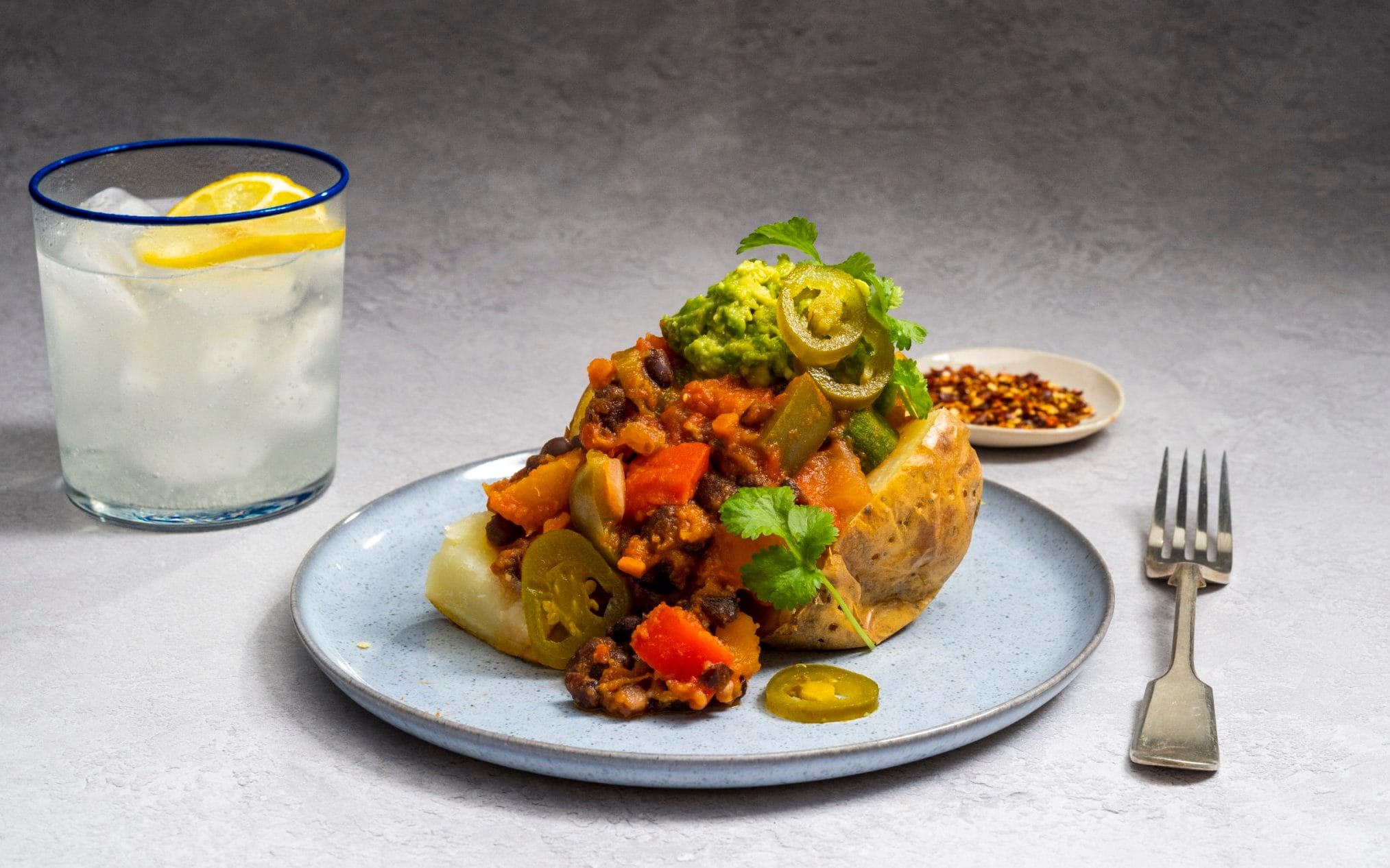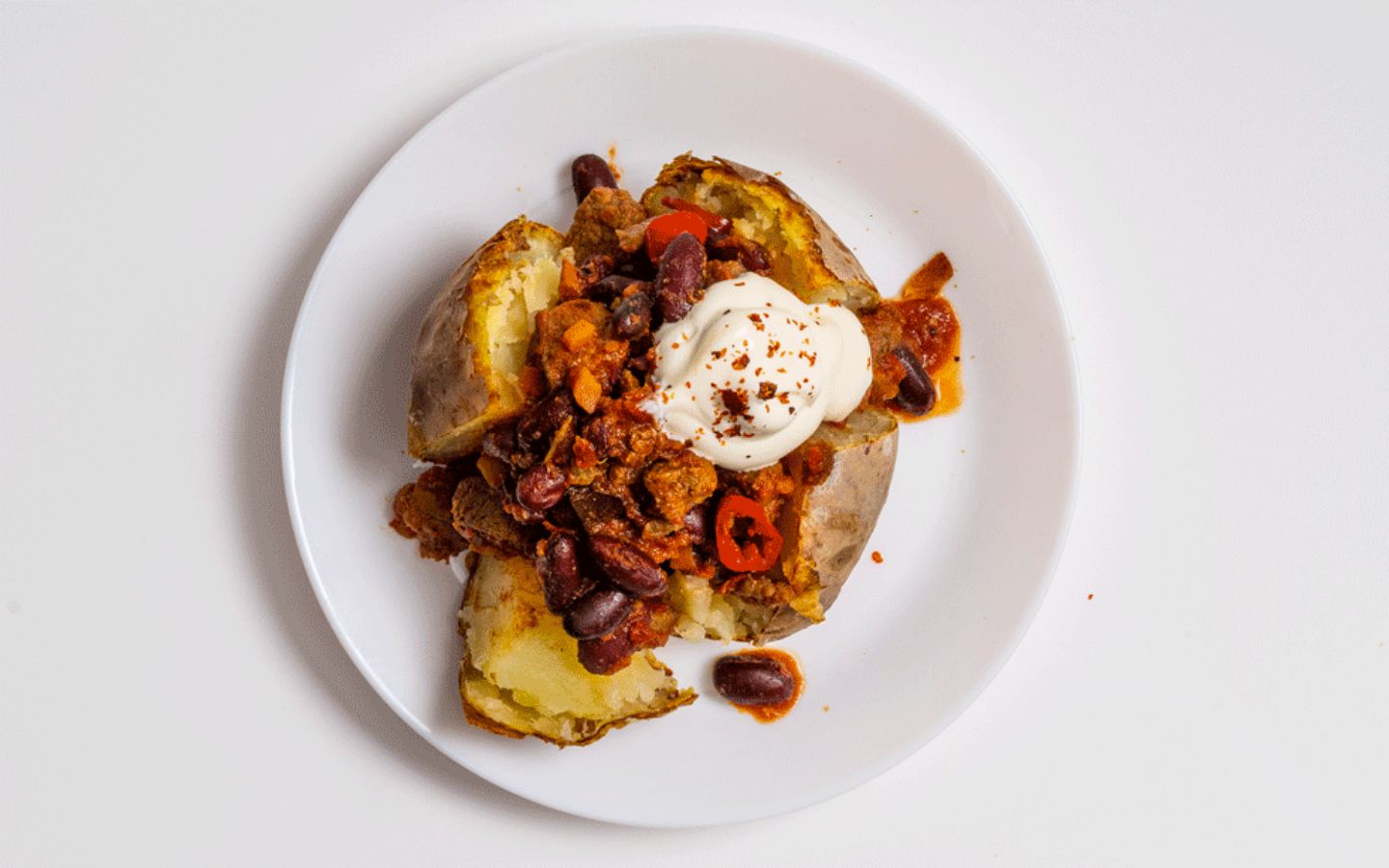

and ladle upon ladle of fillings. However, these mammoth servings aside, baking potatoes is, in fact, the best way to unlock their health benefits, nutritionists say. Here, one shares why we should be eating more of them – and, vitally, what we should be topping them with.
What are the health benefits and pitfalls of baked potatoes?
“Baked potatoes are an inexpensive and nutritious food,” says Farzanah Nasser, a nutritionist.
They offer a decent contribution to our daily fibre intake, containing 4.6g of the 30g we should be hitting each day to support our gut, heart and metabolic health. They also contain 4.4g of protein, hardly any fat (0.4g) and only 188 calories.
Potatoes are also packed with B vitamins, which help prevent DNA damage, antioxidants such as vitamin C, which maintains healthy skin and bones, and minerals like magnesium, which are essential in our diet but many people are deficient in, Nasser notes.
One downside of the baked potato is that it’s high in carbohydrates, with a typical jacket potato containing 39.6g. “This can cause a spike in blood sugar, impacting how you feel,” she says. However, there’s ways of mitigating this.
How can you make baked potatoes healthier?
Adding a topping that contains protein, healthy fats and fibre will make baked potatoes healthier. “Just as you wouldn’t eat a bowl of rice on its own, you also shouldn’t eat a baked potato alone,” Nasser says.
.
Even if you don’t bother with cooling and reheating the baked potato, baking is still one of the healthiest ways of preparing the humble vegetable. “Baking, steaming or microwaving a potato will retain more vitamin C and B vitamins than boiling, as these nutrients are water-soluble and can be lost during cooking when exposed to water,” Nasser explains.
Also, don’t forget to eat the skin, Nasser says. They’re full of fibre, potassium and vitamin C.
“So, foods like the humble potato make a brilliant addition to the diet,” she says.
.
If lathering it on your potato, consider adding a source of protein and fibre as well, such as prawns, hummus, a boiled egg, mashed avocado or leftover stew or curry, Nasser suggests.
When choosing a butter, opt for grass-fed, as it contains more omega-3 (a healthy fat which supports the heart) than regular butter and has a better nutrient profile, she recommends.
If you are worried about your cholesterol, you could swap butter for a good-quality extra virgin olive oil, which provides gut-loving polyphenols and antioxidants, Nasser says. “It also adds a rich, creamy texture to your baked potato,” she says.
However, she suggests steering clear of margarine. Despite studies finding that it may lower cholesterol, it is considered an ultra-processed food as it contains colours, additives and thickeners, she notes.
“Cheese is a great addition to a baked potato, adding protein and calcium,” Nasser says. Each 30g portion (a small matchbox-sized piece), contains 7.6g of protein and 220mg of calcium (around a third of our daily recommended intake).
. Choosing an unpasteurised cheese, which are labelled as unpasteurised or raw and haven’t been heat-treated to kill bacteria, will offer probiotics and further support gut health, she notes. These cheeses are more vulnerable to contain bacteria, like salmonella and E.coli, so care should be taken if eating them.
However, as a meal, a baked potato with cheese doesn’t contain any fibre, which is needed to ensure a healthy blood sugar response and prevent an afternoon energy dip, Nasser says.
and extra virgin olive oil, either on the side or as a starter.
“This combination ticks all the boxes for fibre, protein [at 14.9g per serving] and healthy fats, making it a satisfying choice,” Nasser says.
.
“I would still suggest starting the meal with some greens to help with blood sugar response, as it is still high in carbs (23.3g) from the beans and potato,” she says.
“Tuna is a great protein source and an oily fish that provides omega-3, which we need from our diet as we cannot synthesise it,” Nasser explains.
we should be eating each week for our heart health.
“To make it healthier, you could swap the mayonnaise for yogurt or a mix of yogurt and kefir for added gut benefits, or use Greek yogurt for more protein,” she says.
on the side, as otherwise the meal contains no fibre, Nasser notes.
But, overall tuna mayo is a protein-rich and gut-friendly combo, she adds.
“Coronation chicken, seasoned with herbs and spices, is flavourful and adds goodness, as spices have high levels of antioxidants,” Nasser notes. Turmeric, for example, has anti-inflammatory benefits.”
Each portion, which included shredded chicken combined with mayonnaise, spices, mango chutney and sultanas, contains a protein hit (26g), though it’s low in fibre (1g).
“Try adding chopped greens and fresh herbs to the mixture before adding it to your potato for extra fibre and nutrients,” she adds.
“Cottage cheese is a lovely option, lower in calories and fat with a high protein content,” Nasser says. Each 30g serving contains just 35 calories, 1.7g of fat and 3.2g of protein.
“It’s creamy, filling, and can contain live cultures if indicated on the label,” which aid with digestion and benefit gut health, she notes.
“Chives are a great addition, as they are rich in magnesium, vitamin K and immune-supporting vitamin C,” Nasser says.
However, cottage cheese and chives doesn’t offer up much additional fibre, so she recommends starting with non-starchy greens or a simple green salad.
Made with minced beef, peppers, tinned tomatoes and kidney beans, chilli con carne provides a hit of protein (35.9g) and fibre (3.2g), Nasser says. This means that, while it’s the most calorific topping, it is nutritionally balanced and will help fill you up.
Additionally, the tinned tomatoes are a source of lycopene, a powerful antioxidant that is thought to improve heart health and lower the risk of some cancers.
instead of sour cream will offer gut health benefits, she adds.
Vegetarian chilli contains no meat but typically has extra vegetables, including carrots and celery. “This is fibre-rich baked potato topping,” says Nasser.
While it’s already very healthy, containing just 157 calories, 4g of fat and 9g of fibre, it can be made even healthier by using mixed beans and lentils for more plant diversity, which will support gut health and overall wellness, she says.
As with the traditional chilli con carne, using kefir or Greek yogurt instead of sour cream.
Verdict: What is the healthiest baked potato topping?
Overall, the veggie chilli option is the healthiest baked potato topping, says Nasser. “I love beans because they are rich in fibre, which nourishes the gut,” she says. This topping will also support immune health as it’s high in fibre and probiotics.
However, if you’re looking for a high-protein meal, the regular chilli made with beef is best, she says.
“If you are watching your weight, you might prefer the cottage cheese option; however, be sure to add some greens for additional nutrients to help you stay fuller for longer,” Nasser notes.
Regardless of which topping you choose, make sure to keep an eye on your portion size, which means perhaps swerving those viral baked potato recipes online from the likes of Spud Bros, who add ladles of toppings to one-and-a-half baked potatoes.
“Portion size is important because a baked potato is a high-carbohydrate food, and it’s best to balance it with other foods like protein and fibre,” Nasser says. “It is recommended that a quarter of our plate is carbohydrates (the potato), half should be leafy greens and non-starchy vegetables, and a quarter should be protein.”
Photography by Andrew Crowley
Play The Telegraph’s brilliant range of Puzzles - and feel brighter every day. Train your brain and boost your mood with PlusWord, the Mini Crossword, the fearsome Killer Sudoku and even the classic Cryptic Crossword.


Post a Comment
0Comments